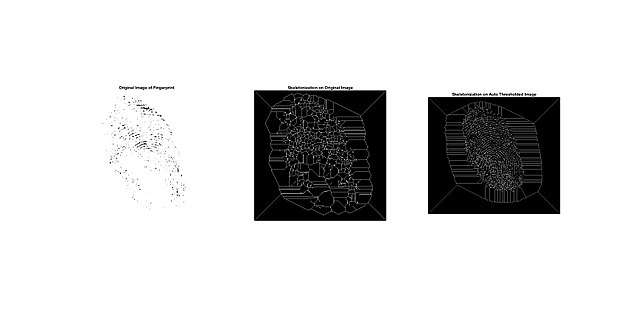Morphological skeleton
In digital image processing, morphological skeleton is a skeleton (or medial axis) representation of a shape or binary image, computed by means of morphological operators.
Morphological skeletons are of two kinds:
- Those defined by means of morphological openings, from which the original shape can be reconstructed,
- Those computed by means of the hit-or-miss transform, which preserve the shape's topology.
Skeleton by openings
Lantuéjoul's formula
Continuous images
In (Lantuéjoul 1977),[1] Lantuéjoul derived the following morphological formula for the skeleton of a continuous binary image :
- ,
where and are the morphological erosion and opening, respectively, is an open ball of radius , and is the closure of .
Discrete images
Let , , be a family of shapes, where B is a structuring element,
- , and
- , where o denotes the origin.
The variable n is called the size of the structuring element.
Lantuéjoul's formula has been discretized as follows. For a discrete binary image , the skeleton S(X) is the union of the skeleton subsets , , where:
- .
Reconstruction from the skeleton
The original shape X can be reconstructed from the set of skeleton subsets as follows:
- .
Partial reconstructions can also be performed, leading to opened versions of the original shape:
- .
The skeleton as the centers of the maximal disks
Let be the translated version of to the point z, that is, .
A shape centered at z is called a maximal disk in a set A when:
- , and
- if, for some integer m and some point y, , then .
Each skeleton subset consists of the centers of all maximal disks of size n.
Performing Morphological Skeletonization on Images

Morphological Skeletonization can be considered as a controlled erosion process. This involves shrinking the image until the area of interest is 1 pixel wide. This can allow quick and accurate image processing on an otherwise large and memory intensive operation. A great example of using skeletonization on an image is processing fingerprints. This can be quickly accomplished using bwmorph; a built-in Matlab function which will implement the Skeletonization Morphology technique to the image.
The image to the right shows the extent of what skeleton morphology can accomplish. Given a partial image, it is possible to extract a much fuller picture. Properly pre-processing the image with a simple Auto Threshold grayscale to binary converter will give the skeletonization function an easier time thinning. The higher contrast ratio will allow the lines to joined in a more accurate manner. Allowing to properly reconstruct the fingerprint.
skelIm = bwmorph(orIm,'skel',Inf); %Function used to generate Skeletonization Images
Notes
- See also (Serra's 1982 book)
References
- Image Analysis and Mathematical Morphology by Jean Serra, ISBN 0-12-637240-3 (1982)
- Image Analysis and Mathematical Morphology, Volume 2: Theoretical Advances by Jean Serra, ISBN 0-12-637241-1 (1988)
- An Introduction to Morphological Image Processing by Edward R. Dougherty, ISBN 0-8194-0845-X (1992)
- Ch. Lantuéjoul, "Sur le modèle de Johnson-Mehl généralisé", Internal report of the Centre de Morph. Math., Fontainebleau, France, 1977.
- Scott E. Umbaugh (2018). Digital Image Processing and Analysis, pp 93-96. CRC Press. ISBN 978-1-4987-6602-9